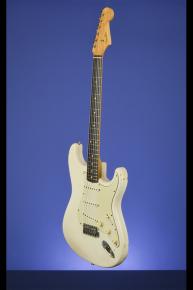1960 Slab-Board Stratocaster - Signed by Stevie Ray Vaughan
1960 Fender Stratocaster
This lightweight Stratocaster with an old Olympic White refin, weighs just 7.30 lbs. One-piece alder body, contoured on the back and the lower bass bout. One-piece maple neck with a nut width of just over 1 5/8 inches, a scale length of 25 1/2 inches. and a very fast thin profile. Brazilian slab rosewood fretboard with 21 medium-thin frets and clay dot position markers. Fender 'spaghetti' decal with "Fender" in gold with black outline. (The "Stratocaster" in black, "With Synchronized Tremolo" and "Original Contour Body" at the ball end of the headstock of the original decal are almost completely worn away, but are clearly visible under ultra-violet light). Single "butterfly" string tree with 'short' metal spacer. Individual single-line Kluson Deluxe tuners with oval metal buttons (stamped inside " D-169 400 / Patent. No"). Four-bolt neck plate with serial number "44522" between the top two screws. Three-layer celluloid "green 'guard" with eleven screws and aluminum shield. Three staggered-pole pickups with outputs of 5.53k, 5.89k, and 6.06k, respectively. Three controls (one volume, two tone) plus three-way selector switch, all on pickguard. White plastic Stratocaster knobs. Fender "Synchronized Tremolo" combined bridge/tailpiece. This early 1960 Stratocaster has no neck date as is usual on examples from this period. The pots are stamped "304 941" and "304-5946" (Stackpole, October & November 1959). Housed in the original Fender two-latch, rectangular tan 'Tolex' hardshell case with brown leather ends and orange plush lining. (8.25).
This guitar was refinished in Olympic White most probably in the 1970s. The then owner took the guitar to a Stevie Ray Vaughan concert in 1989. Stevie Ray Vaughan signed the guitar on the back in gold marker "Stevie Ray Vaughan '89". At a later date the owner also had the guitar signed (in black marker) by Stevie Ray's brother, Jimmie Vaughan. A thin layer of protective varnish was sprayed over the signatures, this has now yellowed. Also on the back of the body is a color 'pin-up' decal. There is some significant belt-buckle wear on the back and a few edge chips. The guitar has been expertly re-fretted wit the correct gauge fret-wire. This guitar has a lot of 'mojo' and it plays, feels and sounds like a mean blues machine.
"With the notable exception of a few months after Spring 1959 and the 1973-1981 period, Stratocaster necks were quite consistently dated at the heel from 1954 onwards. This date is revealed when the neck is removed or at least loosened from the body, so that its bottom end can be examined. Various dating marks have actually been used at the factory over the past decades... After April 1959, the dating procedure was temporarily suspended for several months and then resumed in early 1960. Rumour has it that FENDER stopped marking any date because someone complained about an obscene message penciled on the neck of his new guitar! This explains why the latest Maple Neck Stratocasters from the 1950's and the earliest models with a 'slab' rosewood fretboard do not feature a neck date, although they usually carry a body date!" (A.R. Duchossoir, The Fender Stratocaster, p. 66).
"The Stratocaster was launched during 1954 [and was priced at $249.50, or $229.50 without vibrato]...The new Fender guitar was the first solidbody electric with three pickups [Gibson's electric-acoustic ES-5, introduced five years earlier, had been the overall first], meaning a range of fresh tones, and featured a new-design vibrato unit that provided pitch-bending and shimmering chordal effects. The new vibrato -- erroneously called a 'tremolo' by Fender and many others since -- was troublesome in development. But the result was the first self-contained vibrato unit: an adjustable bridge, a tailpiece, and a vibrato system, all in one. It wasn't a simple mechanism for the time, but a reasonably effective one...Fender's new vibrato had six bridge-pieces, one for each string, adjustable for height and length, which meant that the feel of the strings could be personalized and the guitar made more in tune with itself...The Strat came with a radically sleek, solid body, based on the outline of the 1951 Fender Precision Bass. Some musicians had complained to Fender that the sharp edge of the Telecaster's body was uncomfortable...so the Strat's body was contoured for the player's comfort. Also, it was finished in a yellow-to-black sunburst finish. Even the jack socket mounting was new, recessed in a stylish plate on the body face...the Fender Stratocaster looked like no other guitar around especially the flowing, sensual curves of that beautifully proportioned, timeless body. The Stratocaster's new-style pickguard complemented the lines perfectly, and the overall impression was of a guitar where all the components ideally suited one another. The Fender Stratocaster has since become the most popular, the most copied, the most desired, and very probably the most played solid electric guitar ever" (Tony Bacon, 50 Years of Fender, p. 18).
















